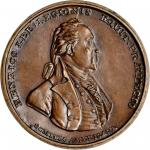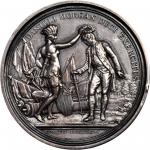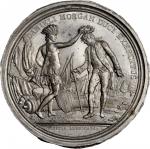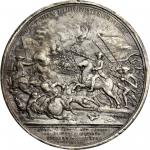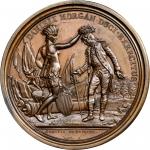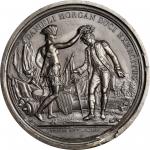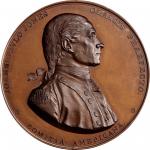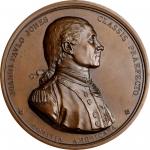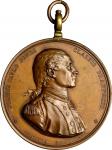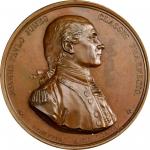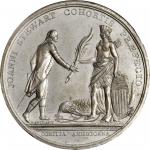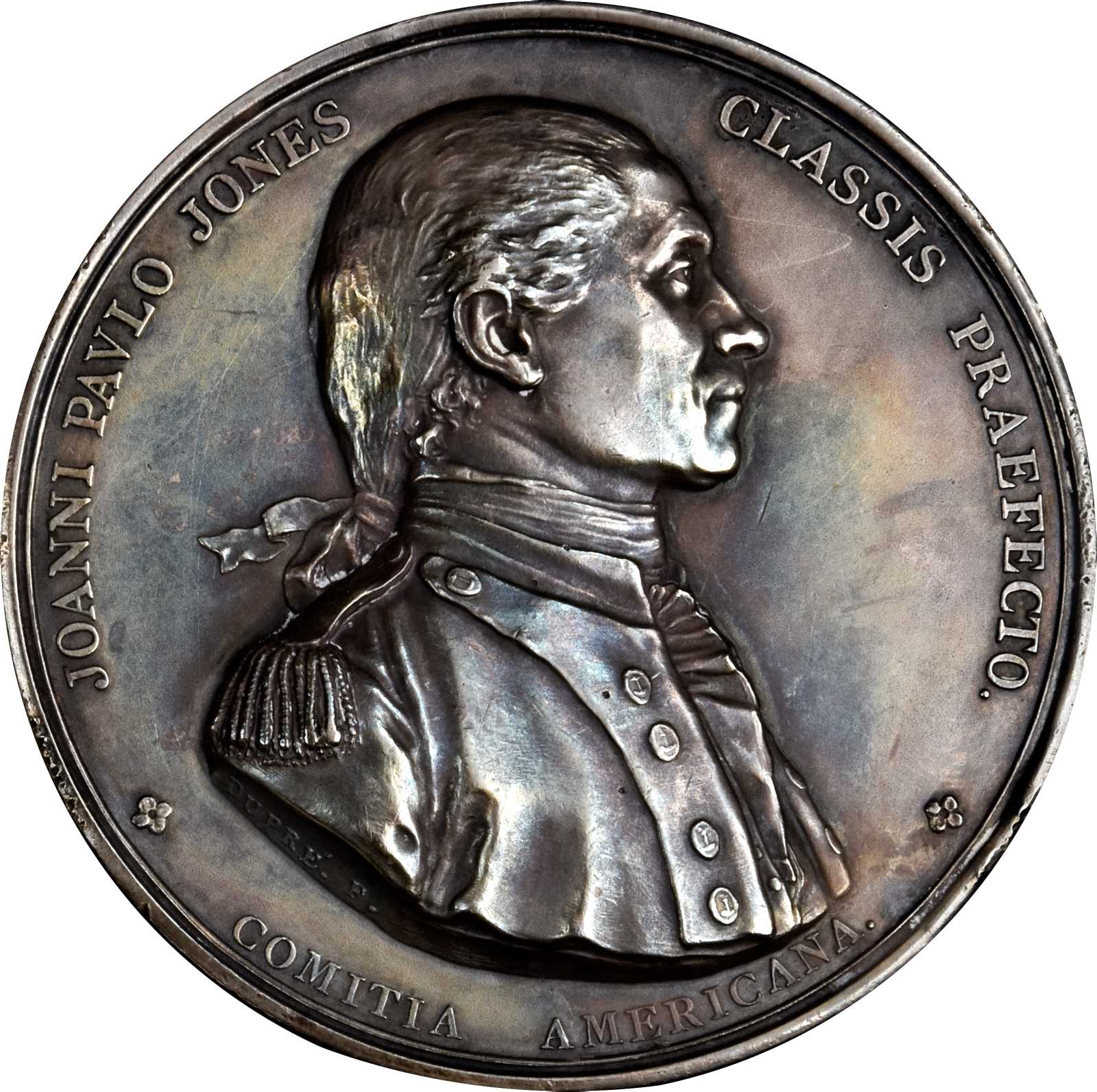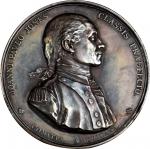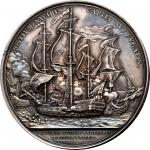1779 (After 1880) John Paul Jones medal. Betts-568. Silver. Original dies, restrike. Paris Mint. 56.1 mm, 1362.4 grains. 3.1 - 3.7 mm thick. About Uncirculated.Square edge marked with cornucopia and ARGENT at 6:00. Iridescent blue, peach, and pale gold toning graces matte medium silver gray surfaces. An attractive piece, though we note a rim bruise at 4:00 on the obverse and several smaller rim nicks on both sides, most notably at 8:00 on the obverse.<p><strong><em>Bonhomme Richard</em> vs. <em>HMS Serapis</em></strong><p><strong>The Action: </strong><p>John Paul Jones, then more commonly called "Paul Jones," was considered a pirate by the British. Leading a small flotilla of French ships (accompanied by one American-built vessel), Jones was the captain of the <em>Bonhomme Richard</em>, named "Poor Richard" in honor of every Frenchmans favorite American, Benjamin Franklin.<p>Beginning in early 1778, Jones and his sailors kept pressure on British shipping and naval vessels from a base in the Brittany port of LOrient. A native of Scotland and a veteran of the Royal Navy, Jones knew the waters of the British Isles well, ably sneaking up on British prizes despite typically being outgunned.<p>As American allies France and Spain made their way toward Great Britain with the Armada of 1779, John Paul Jones and his coterie of ships served as a diversion, making their way to the Irish coast. His feint did not end at, or even threaten, Ireland, but instead made its way overtop of Scotland, into the North Sea, and down the east coast of England.<p>Once there, Jones basically got lucky, running into a substantial convoy of British trading vessels. The British fifth-rate warship HMS <em>Serapis </em>served watch over the 41 ships. Stacked with 44 guns, she was a bit stronger than the longer 42-gun <em>Bonhomme Richard</em>, which had the benefit of the 36-gun <em>Alliance</em> as backup. The <em>Serapis</em> was accompanied by a much smaller vessel, the 22-gun <em>Countess of Scarborough</em>, giving the overall advantage to Jones squadron. The engagement began on the evening of September 23, with the <em>Alliance</em> meeting the <em>Countess of Scarborough</em> while Jones <em>Bonhomme Richard</em> took on the Serapis.<p>John Paul Jones brought his ship close enough to the <em>Serapis</em> to literally tangle the two ships, followed by an unusually brutal series of close broadsides, grenade drops, and man-to-man mayhem. With American sailors tossing incendiary devices from the rigging of the <em>Bonhomme Richard</em> into the hold of the <em>Serapis</em> while the British unleashed their guns, both ships were quickly injured and aflame. Both sides tried to board the other vessel. Both failed. When Captain Richard Pearson hollered to Jones and demanded his surrender, Jones yelled back the words that would make him a legend: "Sir, I have not yet begun to fight!"<p>The terrifying damage to the <em>Serapis</em>, along with the loss of half her crew, forced Pearson to surrender before midnight. The Americans, though victorious, had lost nearly 150 men killed and wounded, and Jones devastated flagship would sink the next day. Fortunately, Jones was able to capture both the <em>Serapis</em> and the <em>Countess of Scarborough</em>, limp them to the Dutch port of Texel, and live to fight another day.<p>Word of Jones victory in English waters spread like wildfire across Europe, making him an instant hero in France. On October 3, 1779, Jones wrote Benjamin Franklin, then in Paris, a long letter describing the battle. Franklin wrote back on October 15, acknowledging Jones concerns about the behavior of Captain Pierre Landais of the <em>Alliance</em>. A court martial ensued over Landais conduct, and the drama - along with Jones generally unpleasant personality - cast a shadow over the action. Congress would not vote Jones a medal for his taking of the Serapis until 1787.<p><strong>The Resolution:</strong><p><em>Resolved Unanimously That a medal of gold be struck and presented to the Chevalier John Paul Jones in commemoration of the valour and brilliant services of that Officer in the command of a squadron of french and American ships under the flag and commission of the United States off the coast of England Great Britain in the late war; And that the Honorable Mr Jefferson Minister plenipotentiary of the United States at the Court of Versailles have the same executed with the proper devices.</em><p><em>Resolved That a letter be written to his Most Christian Majesty informing him that the United States in Congress Assembled have bestowed upon the Chevalier John Paul Jones this medal as well in consideration of the distinguished marks of approbation which his Majesty has been pleased to confer upon that Officer as from a sense of his merit; And that as it is his earnest desire to acquire greater knowledge in his profession, it would be acceptable to Congress that his Majesty would be pleased to permit him to embark with his fleets of evolution; convinced that he can no where else so well acquire that knowledge which may hereafter render him more extensively useful.</em><p><em>- Continental Congress Resolution of October 16, 1787</em><p><strong>The Acquisition:</strong><p>As might be imagined of a Scottish fellow who made his living acting like a pirate on the high seas, Jones was a bit of a tough customer, a pest who thought highly of himself, wrote very long letters very frequently, and was generally rather disagreeable. Its sort of a miracle Congress ever voted him a medal, even almost a decade after his most famous maritime escapade. <p>John Jay wrote to Thomas Jefferson on October 24, 1787, with a parcel of documents, including "A certified Copy of an act of the 16 Octr. Inst: directing you to have a Medal struck in honor of Chevalier Jones, and a copy of a Letter to his most Christian Majesty of the same Date on the same Subject." By this time, Jefferson had been in Paris for three years, serving as the Minister Plenipotentiary, and he had already been working on Comitia Americana medals for a few years. Jefferson appears to have met Jones for the first time about December 1787, when Jones wrote Jefferson in a private letter advising him that he had just arrived in Paris and asked that Jefferson keep his arrival a secret. Jones asked Jefferson to come to apartment 1 of the Hotel de Beauvais, Rue des Vieux Augustines, and ask for "the gentleman just arrived." Jones needed Jeffersons help to free his prizes from the battle with the Serapis, which had been taken to a Danish port and impounded. Because of a century-old treaty with England, the Danes could not pay off Jones for his captured vessels but were bound to return them to the English. Jones wanted his medal, but much more than that, he wanted Jeffersons help in getting paid.<p>Jones does not appear to have brought up his medal to Jefferson for almost a year, until he wrote a letter "on Board the Wolodimer before Oczacoff," afloat with Russias Black Sea Fleet near the modern Ukrainian coast. Jones instructed Jefferson: <p><em>I shall want four Gold Medals as soon as the Dies are finished. I must present one to the United States, another to the King of France, and I cannot do less than offer one to the Empress. As you will keep the Dies for me, it is my intention to have some more Gold Medals struck; therefore I beg you, in the mean time not to permit the striking of a single Silver or Copper Medal. </em><p>Jones also sent information that would helpful in the design of the medal. <p><em>I send inclosed an Extract of my Journal on my Expedition from France to Holland in the Year 1779, for the Information of the Academy of Inscriptions and Belles Lettres. I trust at the same time more to your Judgement than to theirs. There is a Medalist who executed three Medals for me in Wax. One of them is the Battle between the Bon-homme-Richard and the Serapis. The Position of the two Ships is not much amiss, but the accessory figures are much too near the principal Objects; and he has placed them to windward instead of being, as they really were, to Leeward of the Bon-Homme-Richard and Serapis. I do not at this moment recollect the Medallists Name; but he lives on the 3d or 4th Stage at a Marble Cutters, almost opposite, but a Little higher than your former House, Cul de Sac Rue Taitebout and may be easily found. It would be of use to see the medal he has made, although it is by no means to be Copyed. </em><p>Jean-Martin Renauds wax medallion of the battle inspired a print that is illustrated in Volume 16 of The Papers of Thomas Jefferson, which shows that Renauds work most certainly informed Dupres reverse design without serving as a direct source to copy. As the editors of the Jefferson Papers note, "Jones most recent biographer, Samuel Eliot Morison, regards the reverse of the Dupre medal as the most accurate visual depiction of the battle, but points out that Renauds rendition of the scene is nevertheless more accurate in one respect: it correctly shows the Serapis at anchor."<p>By this point, Jean-Antoine Houdons bust of Jones had been completed; it would make a sufficient model for the obverse. Jones wrote Jefferson from St. Petersburg in January 1789 with more autobiographical information that the Academy of Inscriptions and Belles-Lettres would find useful in determining the designs and legends. Jefferson received the completed design information from the Academy soon thereafter, and sent what he received off to Augustin Dupre on February 13, 1789, in a letter that also included the inscriptions for the Morgan at Cowpens medal. Jefferson suggested that the dies should be capable of striking 350 of each medal in gold, silver, or copper. While the mintage of the Morgan medal was far below that, the original dies of the Jones medal survived in working condition well into the 19th century and may have made ten times that figure! Jefferson asked Dupre for "les epreuves en etain au fin du mois de mars prochain" - proofs (i.e. cliches or splashers) in tin at the end of March.<p>Jefferson paid Augustin Dupre for the dies of the medal on March 2 and updated Jones on March 23.<p><em>Having been enabled to carry into execution the orders for the Medals, I have contracted with workmen for them, and they are all in hand. Yours is to be executed by Dupre, who is I think the best among them; and it will be done in the course of the summer. My instructions as to these medals are general, to wit; I am to deliver one of gold or silver (as the case may be) to the person who is the subject; to send one of silver to every sovereign and one of copper to every university of Europe (Gr. Britain excepted) 200 copies to Congress and one a piece to La Fayette, Rochambeau, Destaing, and Degrasse. I am at liberty to deliver no others, not even at the orders and expense of the persons who are the subjects of the medals. But your wish will be fulfilled as to the Empress, because I shall send her a suite of the whole medals under the general order. </em><p><em></em>Jefferson left for the United States in September 1789, his work on this medal finished except for the products receipt and delivery. Dupre took a while to finish his work and delivered it to William Short, Jeffersons former assistant who picked up where he left off. On December 15, Short wrote to John Jay "the medal executed here for Commodore P. Jones, by order of Congress, has lately been received by me and Mr. Grand has paid the Artist its amount agreeable to the contract with Mr. Jefferson, out of the money deposited in his hands for that purpose." <p>Short had a silver medal struck for Jefferson - probably to add to the set presented to President Washington - and sent it to him on August 22, 1790. "I send by the bearer your silver medal of P. Jones which you desired should be made for you. I omitted sending it with your furniture. It has been a long time since I have had the pleasure of hearing from you." Jefferson, who also had a set of splashers in his collection of Monticello, reminded Short of his need for appropriate cliches from the Jones medal on January 24, 1791: "I must pray you to keep in mind and execute the commissions for the clock (which must come entirely by water from Paris to this place) and two epreuves detains of P. Joness medal." Short finally sent them in June, telling Jefferson "You will receive by M. Kellerman who goes to join M. Ternant at Rochefort the tin proofs of P. Joness medal which you desired."<p><strong>The Presentation: </strong><p>While some Comitia Americana medals were presented with florid letters, we have little idea what words accompanied the delivery of Jones congressional prize. William Short wrote to Thomas Jefferson from Paris on May 9, 1790, and mentioned near the end of a long letter "P. Jones has this moment arrived here from London. It is from him I get the intelligence of the press of seamen, which I have interlined above, after having written my letter. I have delivered him his medal."<p>From there, the medal disappears into history. It was not present when his estate was sold - though Gouverneur Morris, his executor, purchased his Society of the Cincinnati eagle badge, his French Order of Merit, and two swords. <p>The dies survived in the Paris Mint, producing several generations of restrikes, until they were delivered to the Philadelphia Mint in 1905. In 1947, they were used to produce a replacement gold medal, which is currently on display in John Paul Jones crypt beneath the United States Naval Academy chapel in Annapolis.<p><strong>The John Paul Jones Medal:</strong><p><strong>Obverse:</strong> A simple design based on Jean-Antoine Houdons majestic bust of Jones, in military attire and epaulets, his hair neatly tied in a queue. Jones faces right, framed by the legend JOANNI PAVLO JONES CLASSIS PRAEFECTO or "John Paul Jones, commander of the fleet. COMITIA AMERICANA appears below, and Dupre signed the bust truncation boldly Dupre F.<p><strong>Reverse: </strong>We cannot improve upon this description from the January 1904 issue of the American Journal of Numismatics. "The combat with the Serapis. The ships are fighting side by side, the British frigate in the foreground under sail to the right; her broadside, though that farthest from her enemy, is shown as badly injured. The Bon Homme Richard, with her bow in the opposite direction, is largely concealed by her adversary, and of her masts only the foremast appears, the topsails backed. The smoke of battle rising between the vessels, floats to the left; two sailors are in the sea clinging to a spar, and another British ship is in the distance. Legend, above, HOSTIVUM NAVIBVS CAPTIS AVT FVGATIS. In the exergue in three lines, the last separated by a rule from those above, AD ORAM SCOTIAE XXIII. SEPT. | M. D. CC LXXVIIII | DVPRE. F. (The ships of the enemy captured or put to flight, off the shore of Scotland, Sept. 23, 1779.)"<p>While the Academy of Inscriptions and Belle-Lettres typically did good work, they failed on this reverse: the battle took place off the shore of England, roughly 175 miles south of the Scottish border.<p><p>From the John W. Adams Collection. Acquired from Spink’s sale of June 1989, lot 406.









